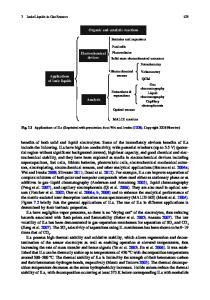Ionic liquids for energy applications
- PDF / 802,890 Bytes
- 5 Pages / 585 x 783 pts Page_size
- 44 Downloads / 438 Views
Introduction Energy use and production are without a doubt the main causes behind the pollution of our cities and current climate change. Decreasing emissions from the transport sector as well as from the production of electricity, simultaneously with the continual increase in energy consumption and the need for mobility—not the least in emerging economies—is the biggest challenge we face today. Not surprisingly, there is a strong effort in the development of sustainable technologies for clean electricity production and energy conversion. In the short term, progress can be made with improved efficiency of processes. One example is the strong trend today with small and highly efficient combustion engines in new cars, which help to cut fuel consumption, in some cases, by more than 50% compared to standard models sold 10 years ago. Another example is the improved efficiency of thermal power plants by optimizing the combustion process (e.g., increasing the temperature). However, to achieve true sustainability in the long term, the only solution is to move to renewable energy sources and to go from combustion engines to electric drive trains. Several steps have already been taken on the path to sustainability (also see the April 2012 special issue of MRS Bulletin on “Materials for sustainable development”)—installation of wind farms, solar cells in private houses, and an increasing number of hybrid vehicles. The principal concepts are there, but in many cases, the key components for large-scale implementation are
lacking. To take the next step, performance, cost, reliability, and safety need to be improved. As for many other technology areas, the lack of sufficiently good materials is one of the main limiting factors. In the transport sector, the major hindrance for large-scale implementation of electric vehicles is the lack of safe and low-cost large capacity energy storage systems. Li batteries are the main candidate being considered, but capacity and safety issues, the latter mainly due to the presence of a volatile electrolyte, are slowing down progress. Fuel cells, converting hydrogen to electricity, were demonstrated in automotive applications some 17 years ago,1 but also in this case, an optimal electrolyte is lacking. The target here, from the automotive industry, is an operating temperature of around 110–130°C. The US Department of Energy (DOE) target for automotive applications is 120°C to allow efficient electrode reactions and to move away from expensive and unsustainable noble metal catalysts. In this issue of MRS Bulletin, we highlight the potential of ionic liquids (ILs) in energy applications that can contribute significantly to the transition to sustainable production of electricity and use of energy. In this article, we provide an introduction to ILs and their properties, with these serving as the basis for the other topical articles in the issue on efficient and environmentally friendly synthesis methods for new ILs (Passerini and Appetecchi), Li batteries (Navarra), supercapacitors (Brandt et al.), fuel ce
Data Loading...











